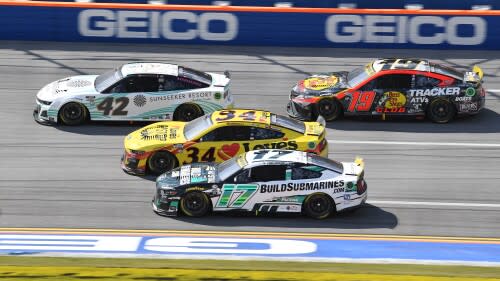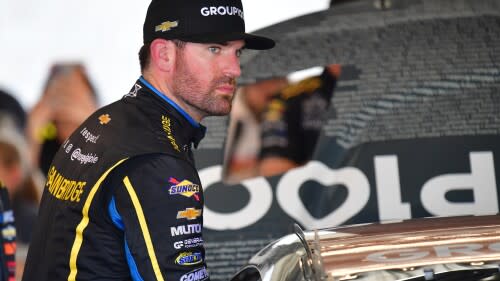NASCAR Cup drivers prepare for 'aggressive' fuel saving at Talladega
TALLADEGA, Ala. — The Next Gen car has brought many changes to NASCAR. One of the biggest is how teams compete on superspeedways. Teams focus on saving fuel and running at close to half-throttle instead of pressing for track position.
This is what drivers expect to see once again Sunday at Talladega Superspeedway (3 p.m. ET on Fox).
"For the fans' sake, I hope it's not a lot (of fuel saving Sunday), but it probably will have some just simply because that's the nature of the game," Denny Hamlin said. "You just want to have the shortest pit stop possible because it is a such a track position race.
"The days of Dale Earnhardt going from wherever to the front, it just isn't possible with the way that we draft these Next Gen cars."
Talladega Cup starting lineup: Michael McDowell wins pole
Fox will provide coverage for Sunday’s Cup race at Talladega Superspeedway.
Fuel saving has long been a part of NASCAR, especially with stages being longer than the distance a car can go on fuel.
However, other factors have made fuel saving far more critical at superspeedways.
The one-lug wheels take less time to change than the five-lug wheels that were used on the Gen 6 cars. This means that it takes longer to fuel the car than change four tires on a pit stop.
The less fuel burned on the track means less time in the pit stall and potential positions gained in the pack when passing is more difficult.
"Excessive fuel saving" became more prominent during the season-opening Daytona 500 as drivers tried to limit the amount of fuel used so that they could spend less time on pit road.
Joey Logano won the pole for the Daytona 500 with a 49.465-second qualifying lap. By Lap 19, leader Christopher Bell's pace was 49.730 seconds. Fast-forward to Lap 29 of the race, Bell's lap time was 51.307 seconds.
Some drivers responded to this fuel saving with critical comments. Kyle Busch said after the Daytona 500 that he felt "disgraceful" due to the excessive fuel saving and that he felt bad for the fans. Chris Buescher said that "this was the least amount of fun" that he had in a Daytona 500.
How to watch Talladega Cup race Sunday: Start time, forecast, TV info
Cup drivers compete at the longest superspeedway on the circuit.
As Austin Dillon explains, the sentiment has not changed as the season has progressed.
"I think teams would like to get away from this fuel saving and that type of race and be more wide open — I know we would like it — but it's just kind of what works right now," Dillon said. "So you're trying to do it efficiently and be the best at it."
This emphasis on fuel saving also means that there aren't opportunities to work through the field and gain track position. If a driver lines up near the rear of the field, it's possible they will remain there until they head down pit road for fuel and tires.
"Before, you could kind of bail out and get yourself out of situations that didn't feel good," Daniel Hemric said. "Now it's harder and harder to get back that track position."
This focus on riding around and fuel-saving helps teams strategize for the final pit stop of the race, which sets up a final push to the checkered flag. It keeps cars together for the majority of the race.
What the fuel saving doesn't do is provide more learning opportunities for drivers with rookie stripes on the rear of their cars.
"It's a little easier for the guys with more experience just to commit to the fuel saving," Josh Berry said.
"But for someone like me that's still learning, I think it's important to balance actually racing some and getting some experience with pushing and receiving pushes and trying to race up front and keep some track position."
Based on comments made by drivers Saturday, Berry may not get the opportunities to race aggressively at Talladega and continue his NASCAR education. The expectation is that fuel saving will continue to be a focus for the majority of the 500-mile race, for better or worse.
"I think now everyone has gotten used to (fuel saving) and I think people have figured out how to counter it, so you might see an interesting deal there," Blaney said. "We’re in this weird spot. A lot of guys are gonna be saving gas.”


